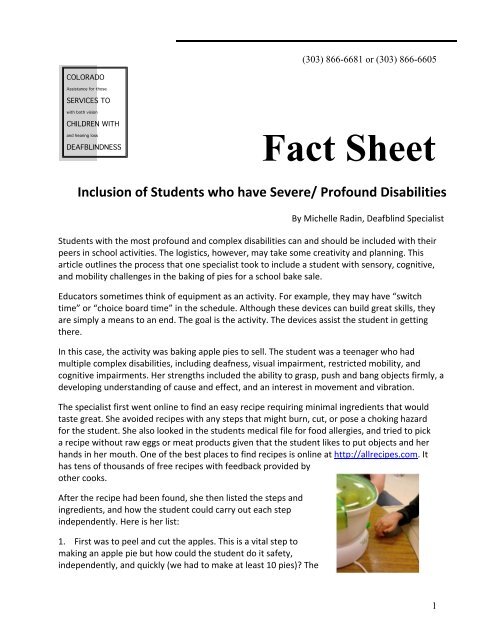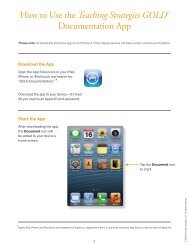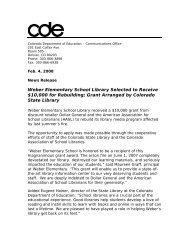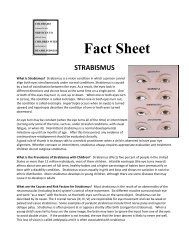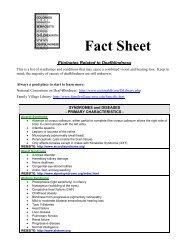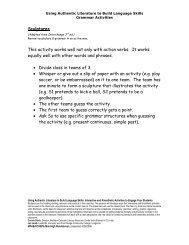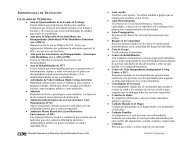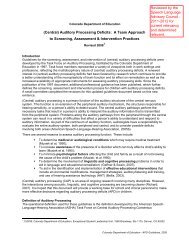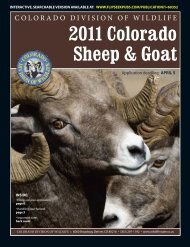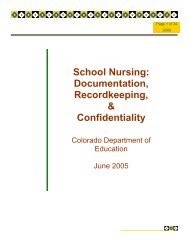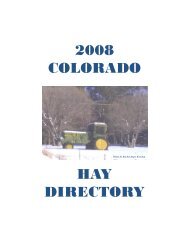Inclusion For Students with Severe and Profound Disabilities
Inclusion For Students with Severe and Profound Disabilities
Inclusion For Students with Severe and Profound Disabilities
Create successful ePaper yourself
Turn your PDF publications into a flip-book with our unique Google optimized e-Paper software.
(303) 866-6681 or (303) 866-6605<br />
Fact Sheet<br />
<strong>Inclusion</strong> of <strong>Students</strong> who have <strong>Severe</strong>/ <strong>Profound</strong> <strong>Disabilities</strong><br />
By Michelle Radin, Deafblind Specialist<br />
<strong>Students</strong> <strong>with</strong> the most profound <strong>and</strong> complex disabilities can <strong>and</strong> should be included <strong>with</strong> their<br />
peers in school activities. The logistics, however, may take some creativity <strong>and</strong> planning. This<br />
article outlines the process that one specialist took to include a student <strong>with</strong> sensory, cognitive,<br />
<strong>and</strong> mobility challenges in the baking of pies for a school bake sale.<br />
Educators sometimes think of equipment as an activity. <strong>For</strong> example, they may have “switch<br />
time” or “choice board time” in the schedule. Although these devices can build great skills, they<br />
are simply a means to an end. The goal is the activity. The devices assist the student in getting<br />
there.<br />
In this case, the activity was baking apple pies to sell. The student was a teenager who had<br />
multiple complex disabilities, including deafness, visual impairment, restricted mobility, <strong>and</strong><br />
cognitive impairments. Her strengths included the ability to grasp, push <strong>and</strong> bang objects firmly, a<br />
developing underst<strong>and</strong>ing of cause <strong>and</strong> effect, <strong>and</strong> an interest in movement <strong>and</strong> vibration.<br />
The specialist first went online to find an easy recipe requiring minimal ingredients that would<br />
taste great. She avoided recipes <strong>with</strong> any steps that might burn, cut, or pose a choking hazard<br />
for the student. She also looked in the students medical file for food allergies, <strong>and</strong> tried to pick<br />
a recipe <strong>with</strong>out raw eggs or meat products given that the student likes to put objects <strong>and</strong> her<br />
h<strong>and</strong>s in her mouth. One of the best places to find recipes is online at http://allrecipes.com. It<br />
has tens of thous<strong>and</strong>s of free recipes <strong>with</strong> feedback provided by<br />
other cooks.<br />
After the recipe had been found, she then listed the steps <strong>and</strong><br />
ingredients, <strong>and</strong> how the student could carry out each step<br />
independently. Here is her list:<br />
1. First was to peel <strong>and</strong> cut the apples. This is a vital step to<br />
making an apple pie but how could the student do it safety,<br />
independently, <strong>and</strong> quickly (we had to make at least 10 pies)? The<br />
1
specialist searched the Internet for “automatic apple peeler” having no idea what would come<br />
up. She found this: A fairly inexpensive machine that peels apples or potatoes. Because it plugs<br />
in, it could be switch adapted <strong>with</strong> the use of a power link, a very useful device that can adapt<br />
any device that can be plugged in to be switch‐adapted. A vibrating timer alerted the student<br />
when it was time to stop the peeler.<br />
2. The apples needed to be sliced. The “slicing” mode on the classroom’s<br />
food processor was hooked up to a power link. The<br />
power link was then attached to a jelly beamer switch, a wireless<br />
plate‐type switch.<br />
3. Apples <strong>and</strong> other ingredients were poured into a large bowl.<br />
Instead of having a teacher do this part of the activity, it was<br />
adapted so that the student could participate in a few steps.<br />
a. First the apples were poured by a teacher into the bowl. Then the<br />
student used a grasp switch to pour ingredients into the bowl.<br />
Although the most common switches are the plate type, activated by<br />
a push of a large button, there are many others. This specific switch is<br />
activated by a tight squeeze of the h<strong>and</strong>, a motion that the student was<br />
known to be able to do easily. When she squeezed the tube, the<br />
pourer turned on. She was also able to do this purposefully, it wasn’t<br />
the result of responsive or seizure‐type movements, which are<br />
sometimes made <strong>with</strong>out a student’s awareness, <strong>and</strong> trying to shape<br />
these types of movements often doesn’t have the desired effect.<br />
This picture shows a measuring spoon hooked up to the pourer. Here<br />
the grasp switch, seen in the bottom center of the picture, is used.<br />
Squeezing it would signal the pourer to turn the measuring spoon,<br />
which would dump its contents into the bowl below.<br />
b. Another student, also <strong>with</strong> significant disabilities, had the<br />
job of measuring the flour <strong>and</strong> spices. He was given a<br />
communication board. It first had a colored measuring cup or<br />
spoon. He would find the spoon or cup that matched the<br />
picture, each of the cups <strong>and</strong> spoons had their own color.<br />
They were purchased at a company that supplies equipment<br />
for adults who are blind/visually impaired. He then looked at<br />
the next symbol, which pictured an ingredient. He used the spoon or cup to measure out the<br />
ingredient <strong>and</strong> put it into the bowl. If there were more than one needed, the communication<br />
board would have multiple symbols for the ingredient. As he<br />
poured each one, he would pull its symbol off the board.<br />
c. Another device used to pour the milk was called a roll‐n‐pour.<br />
The roll‐n‐pour was designed for people <strong>with</strong> orthopedic<br />
disabilities. It holds a milk jug <strong>and</strong> uses gravity to pour it slowly<br />
<strong>with</strong> the touch of one finger. With a second touch, the jug rights<br />
itself.<br />
2
We placed a device called a level indicator in the measuring<br />
cup. This makes a chime or vibration when liquid hits a certain<br />
level in the measuring cup. The student was alerted to touch<br />
the roll n’ pour again, which would make it stop pouring.<br />
4. The pre‐mixed pie dough then<br />
had to be rolled out <strong>and</strong> placed in<br />
the pie plate. A clear plastic sleeve was used to make it easier to roll<br />
out the right shape of dough. The sleeves are available from many<br />
sites, <strong>and</strong> are used by cooks <strong>and</strong> bakers. Both students rolled out<br />
the dough, using rolling pins <strong>and</strong> their h<strong>and</strong>s.<br />
5. A teacher poured the ingredients from the bowl into the<br />
piecrust. The students used gloves <strong>and</strong> cookie cutters <strong>with</strong> Velcroto<br />
cut out the top crust, which were used to make leaf‐shaped holes.<br />
Using this technique, the student simply had to bring her h<strong>and</strong><br />
down repeatedly, <strong>and</strong> the cookie cutter made the right shaped<br />
holes.<br />
6. The pies were then ready to bake <strong>and</strong> eat or sell!! The best part!<br />
Printed <strong>with</strong> permission from the original source: Alaska Dual Sensory Impairment Project,<br />
Keeping in Touch Newsletter, Winter 2010/Spring 2011 issue<br />
<strong>For</strong> more information about the CO Services for Children <strong>and</strong> Youth <strong>with</strong> Combined Vision<br />
<strong>and</strong> Hearing Loss Project contact:<br />
Tanni Anthony<br />
Gina Quintana<br />
Phone: 303‐866‐6681 Phone: 303‐866‐6605<br />
Email: anthony_t@cde.state.co.us<br />
Email: quintana_g@cde.state.co.us<br />
Colorado Department of Education Fax: 303‐866‐6767<br />
Exceptional Student Leadership Unit<br />
1560 Broadway, Suite 1175, Denver, CO 80202<br />
Web Page Address: www.cde.state.co.us/cdesped/Deafblind.asp<br />
Fact Sheets from the Colorado Services to Children <strong>and</strong> Youth <strong>with</strong> Combined Vision <strong>and</strong> Hearing<br />
Loss Project are to be used by both families <strong>and</strong> professionals serving individuals <strong>with</strong> vision <strong>and</strong><br />
hearing loss. The information applies to children, birth through 21 years of age. The purpose of<br />
the Fact Sheet is to give general information on a specific topic. More specific information for<br />
an individual student can be provided through personalized technical assistance available from<br />
the project. <strong>For</strong> more information call (303) 866‐6681 or (303) 866‐6605. Updated: 9/11<br />
3


